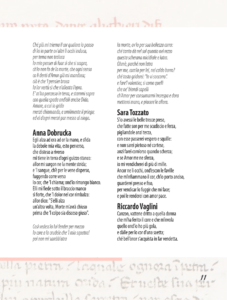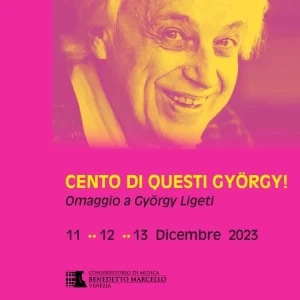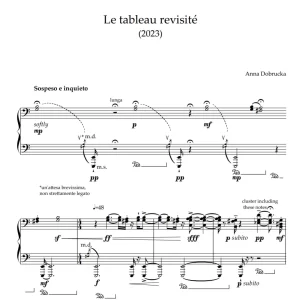OPERA in III ACTS for 5 soloists, choir, orchestra and vocal octet
Premiere: 18 April 2024, Teatro Malibran, Venice, Italy
Conductor: Giovanni Mancuso
Performances:
18, 19, 20, 21 April, 2024 – Teatro Malibran, Venice, IT
November 2024 – Huangzhou, China – with the participation of the President of Italy Sergio Mattarella
Interview for La Fenice:
for Flute, Baritone Saxophone, Bassoon, Baritone Voice, Vibraphone, Violin, Piano.
Commissioned by Francesco Pavan for the Venice Art Night 2024. Premiered on June 21st, 2024.
Duration: circa 7 minutes
Baritone voice is treated here as an instrument.
Summer Solstice – celebration of the moment when astronomical summer begins and the Sun perpendicularly illuminates the Tropic of Cancer. The shortest night of the year was devoted to wild parties and the customs and rituals celebrated at this time were intended to ensure health and fertility. The celebration peculiar to the Slavic peoples is called Noc Kupały. The night of Kupala also opens the ‘bathing season’. It was believed that before that feast, water men and women (wodniki, wodnice), drowners and water demons of all kinds lurked in rivers, streams and lakes to lure the thirsty people into summer. Only after the shortest night of the year were all bathers safe from the temptations of impure forces. The celebration of the summer solstice could not be eradicated from popular rituals and sensibilities, so the Catholic church tried to assimilate the feast, which was after all completely pagan, into Christian rituals. This is how the tradition of celebrating the eve of the liturgical memory of St John the Baptist, also commonly known as Midsummer’s Eve, came about.
DUALITY in Solstice (2024)
The composition, similarly, presents an interpenetration of “pagan” nature (the character of the violin part – ‘fiddle like’, with fifths and chords, characteristic of Slavic folk music, the use of low register instruments and prepared piano: muted, percussive sounds, freedom of interpretation – improvised parts, free tempo) and “Christian” themes (chords reminiscent of the plagal cadences characteristic of church music, the parts with a more rigorous character and specific metrics and tempo, the use of the vibraphone to create a celestial sound impression).
Main concepts
CHANGES AND VARIATIONS IN TIMBRE
THE BARITONE VOICE TREATED AS AN INSTRUMENT
IL VIOLINO CONCERTANTE
THE INSTRUMENTS WITH THE LOW REGISTER
PREPARED PIANO
ERRORS APPRECIATED
ALTERNATING BETWEEN UNMEASURED AND MEASURED PARTS
IMPROVISED MOMENTS
Commissioned by the Gustav Mahler Research Center in Toblach, IT for the Festival Gustav Mahler Musikwohe in July 2023. Conducted by Clemens Heil. What the Animals Tell Me is a recomposition of the third movement of Mahler’s Symphony No. 3. Dobrucka interprets Mahler’s depiction of the animal world as “rather light and playful” and confronts it with her own contrasting experiences. She writes: “After weeks of traveling through the Australian bushland, I associated the wildlife more with the feeling of confrontation with the dangers of the wilderness”. One of the feelings that comes with being in a foreign environment is that of uncertainty about the meaning of what you hear, as the sources of the sounds are not understandable due to a lack of knowledge and experience and are not always obvious. What they might suggest is left to the imagination. To approach the effect musically, Dobrucka began her work with the question “How can you create an animal sound with musical instruments in such a way that it is not programatic and immediately recognisable?”
The premiere will take place at the Italian Festival Camino Contro Corrente XIVth edition Le brutture in March 2023
Composition for bass voice and an ensemble of 5 instruments based on the extract from the Paradise Lost by John Milton
///
Composizione per voce di basso ed ensemble di 5 strumenti basata sul testo del Paradiso Perduto di John Milton
“Is this the Region, this the Soil, the Clime,
[…] this the seat
That we must change for Heav’n, this mournful gloom
For that celestial light? Be it so, since he Who now is Sovran can dispose and bid
What shall be right: farthest from him is best
Whom reason hath equall’d, force hath made supreme
Above his equals.
Farewell happy Fields Where Joy for ever dwells: Hail horrors, hail Infernal
world, and thou profoundest Hell
Receive thy new Possessor: One who brings
A mind not to be chang’d by Place or Time.
The mind is its own place, and in itself
Can make a Heav’n of Hell, a Hell of Heav’n.”
The composition is based on the text of the first anthem of Poland.
Recording: My Fatherland within my soul (Отечество мое – в моей душе) (2024/2025) based on the poem of Marc Chagall by the multi-award winning vocal ensemble ART’N’VOICES
For the mixed choir of 100 people, site specific composition performed from the windows and balconies of the Palazzo Pisani in Venice towards the public on June 21st, 2024.
See ORCHESTRA/BIG ENSEMBLE
Commissioned by Festival Camino Contro Corrente, to be performed in March 2023
The composition is based on the text of the first anthem of Poland.
Written for the italian festival Camino Contro Corrente XIIIth edition Antico Anticato Antiquato.
Premiered on the 11.03.2022 in Camino al Tagliamento, Italy.
The text of Dante’s poem was divided into 7 parts. Each part was used by a different composer.



UTRATA means “loss”. The piece tells stories from Fryderyk Chopin’s life and includes citations from his celebrated pieces translated into 4 voices.
Lyrics written by Magdalena Krakowska.
The composition won a special prize at the International Kosciuszko Bicentenary Competition.
Premiered at the Kosciuszko Bicentenary Competition Gala in Sydney on 3rd October 2017.
Premiere in Venice, 2025
Premiere: June 7th 2025 at the Palazzo Pisani in Venice
Commission by Carlo Lazari e Carlo Teodori from the EX NOVO ENSEMBLE
Premiere: 12.06.2024 at Palazzo Pisani, Venice
Flute – Sara Valle
Cello – Jakub Jakubowski
Live electronics + spatialization – Leonardo Zoleo, Anna Dobrucka
Premiere: March 7th by Zarębski Piano Duo at the Music by Women Festival in Mississippi, USA
From Monteverdi – Pur ti miro, from L’Incoronazione di Poppea (1643): a recomposition by Anna Dobrucka – Pur ti miro (2023) for soprano, accordion, electric guitar, theorbo and live electronics.
This was a project for the residency in Eesti Muusika-ja Teatriakadeemia during the Commute festival in April 2023, with the italian ensemble Azione Improvvisa. The extremely unusual formation of the ensemble is focused on the exploration of new sound identities in the context of contemporary music, linking different approaches and experiences in a synergetic combination of musical instruments from different eras. The first part of the piece, not presented here, was written by another composer, Josef Zachariassen.
Anna Dobrucka: “Since the original “Pur ti miro” is a dialogue between two lovers, I came up with the idea of a dialogue of breaths, sighs and whispers between accordion and soprano – as an echo and a pre-linguistic anticipation of the dialogue between the lovers in Busenello’s text, the intonated sounds gradually emerge, according to an interpretation of love characterised by tenderness and delicacy. As if those words were so difficult to pronounce that their direct and rather unmediated diction made them risk cracking and becoming silent. After analysing and breaking down the “settenari” of the literary text in Italian from Pur ti miro, I translated it into English, extracting some phrases and isolated words.
Although the recomposition of Pur ti miro was not a personal choice (having been assigned to me by the festival’s artistic direction), I found it incredibly inspiring to work on a piece that allowed me both to investigate the timeless subject of love from an all-new angle, where the great harmonic, instrumental and expressive freedom that I had at my disposal was counterbalanced by the continuous reference to the original, considered precisely as a text to be recomposed, which therefore never ceases to be present and to continue speaking to us.”
A piece that explores communication between the two players:
Duration of notes ad libitum, synchrony not always required, quiet breathing.
All haromonics realised very expressively.
Attacks marked with the vertical dotted line are to be played together.
Celadon ( 青瓷) is a type of pottery, typical of China that uses a glaze
(a transparent vitreous coating) green or translucent blue-grey.
Premiere – Palazzo Pisani, Venezia 9 June 2022
Alvise Mason – first organ, Costanza Pasquotti – second organ, Sviatoslav Avilov – registri
Le pietre di Venezia
1. Aurora a Punta della Dogana
2. Masegni
3. Il tempo
4. Nel centro di San Marco
The inspiration for the piece for two organs occurred to me when I discovered and delved into the history of St Mark’s Basilica, which among its many primacies also has that of having been the place where the idea of stereophonic music was born. The architecture of the Basilica allowed Venetian composers as early as 1500 to try out stereophonic sound by dividing the choirs and placing the singers in different spaces of the church. The piece for two organs was written strictly for the organs of the Concert Hall of Palazzo Pisani in Venice. The left organ makes no use of the pedalboard and has only one keyboard.
The piece explores the journey of sound through space. It is inspired by the footsteps that every day get lost among stone labyrinths, deserted campi and campielli; by the reflections of water on walls and under bridges, by the sound of water at night; by a Venice as few have ever seen it – empty.
In the first two parts of the piece, similar harmonies travel between the two instruments. The third part makes use of registers that, slowly extracted, produce the glissando effect. The third part is recorded live and then played back from eight loudspeakers around the audience. The sound is then mixed with pre-recorded ambient sounds from St. Mark’s Square and short recordings from the Capella Marciana of St. Mark’s Basilica. The sound will travel from one loudspeaker to another giving the impression of being in the centre of the moving sound.
//
Il brano per due organi è stato scritto rigorosamente per gli organi della Sala Concerti di Palazzo Pisani a Venezia. L’organo sinistro non fa uso della pedaliera ed ha una sola tastiera.
Nelle prime due parti del brano armonie simili viaggiano tra i due strumenti. La terza parte si avvale dei registri che, estratti lentamente, producono l’effetto glissando. La terza parte viene registrata dal vivo e poi riprodotta da 8 altoparlanti intorno al pubblico. Il suono viene poi mescolato con suoni ambientali preregistrati provenienti dalla Piazza San Marco e le registrazioni brevi della Capella Marciana della Basilica di San Marco. Il suono viaggerà da un altoparlante all’altro dando l’impressione di essere al centro del suono in movimento.
The premiere took place at the Italian Festival Camino Contro Corrente XIVth edition Le brutture in March 2023
Composition for bass voice and an ensemble of 5 instruments based on the extract from the Paradise Lost by John Milton
///
Composizione per voce di basso ed ensemble di 5 strumenti basata sul testo del Paradiso Perduto di John Milton
“Is this the Region, this the Soil, the Clime,
[…] this the seat
That we must change for Heav’n, this mournful gloom
For that celestial light? Be it so, since he Who now is Sovran can dispose and bid
What shall be right: farthest from him is best
Whom reason hath equall’d, force hath made supreme
Above his equals.
Farewell happy Fields Where Joy for ever dwells: Hail horrors, hail Infernal
world, and thou profoundest Hell
Receive thy new Possessor: One who brings
A mind not to be chang’d by Place or Time.
The mind is its own place, and in itself
Can make a Heav’n of Hell, a Hell of Heav’n.”
The composition is based on the text of the first anthem of Poland.
Recording/premiere: Prahran (2021) for cello quartet by Joëlle Mauris in Geneva, CH
Commisioned and performed by Duo Jost Costa at the Italian Festival Camino Contro Corrente XII (theme: Insecurity, Immigration) on January 16, 2021.
In Fuga (On the run) has nothing to do with the musical form of Fuga though at first it may resemble one due to the repetition of the theme in different voices. In fuga tells the story of a blind race of people overwhelmed by their own destiny. A tragic journey in which insurmountable obstacles follow one another like walls erected to keep strangers out. The escape ends with the resigned realization that the barriers are not only the material ones and there is therefore a little hope of getting around them.
Performed by Brandon Lee and Anna Dobrucka at the Tempo Rubato
Melbourne, Australia 28.01.2020
Premiere: at the 50th INTERNATIONAL VIOLA CONGRESS in Paris – commissioned by Kinga Wojdalska
Premiere: November 15th at the II Congreso Internacional EPTA in Madrid, Spain, by Piotr Różański: Contemporary Polish Piano Music for the Left Hand
The recomposition inspired by Rachmaninov’s Etude Tableaux op. 33 nr 5 in d-minor
Premiere: December, 11th 2023 at the Ligeti Festival/ Hommage in Venice, Italy
Performed by Michelangelo d’Adamo



Written for violist Kinga Wojdalska. Premiered in Zürich, Switzerland on June 6th, 2023.
The piece is based on the book with the same title by the French philosopher Simone de Beauvoir. It explores the ambiguity of perception of our behaviors and reasons for acting.
I chose a solo instrument that has limited possibilities of producing harmony, therefore I worked mainly with a single melody line. The composition is focused on showing different nuances of the same motive and using extended techniques and microtones.
Performed by Anna Dobrucka at the Tempo Rubato in Melbourne, Australia 28.01.2020
Premiered at the Kosciuszko Bicentenary Competition Gala in Sydney on 3rd October 2017.
Music inspired by the poem of Pawel Dobrucki (Winner of the 1st prize for poetry in the International Kosciuszko Bicentenary Competition).
Premiered by Ella-Mei Graham at Tempo Rubato in Melbourne, Australia 28.01.2020